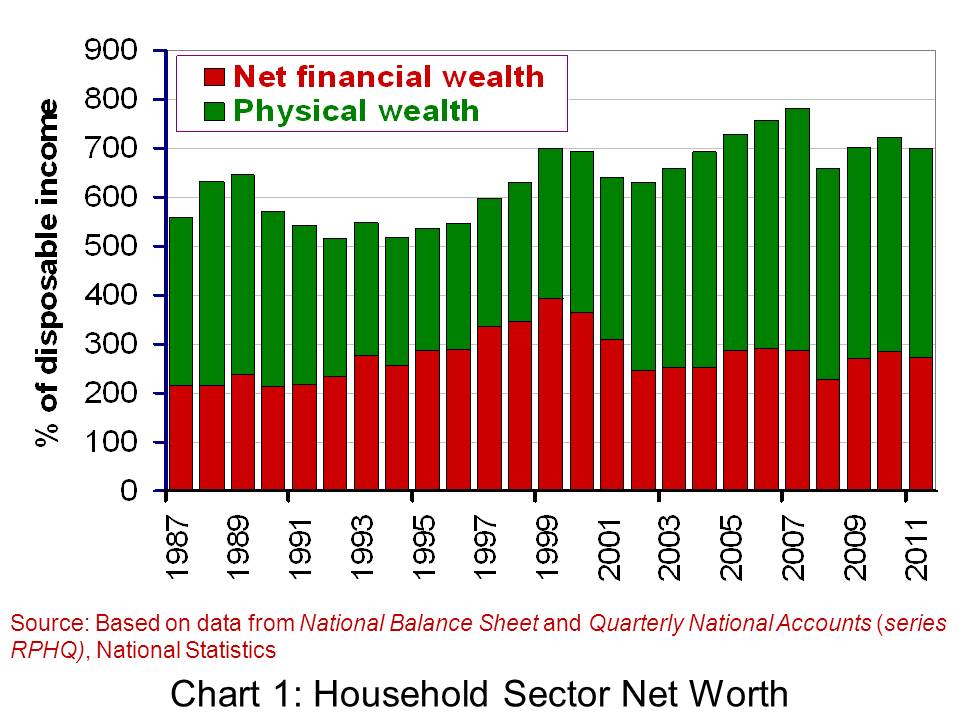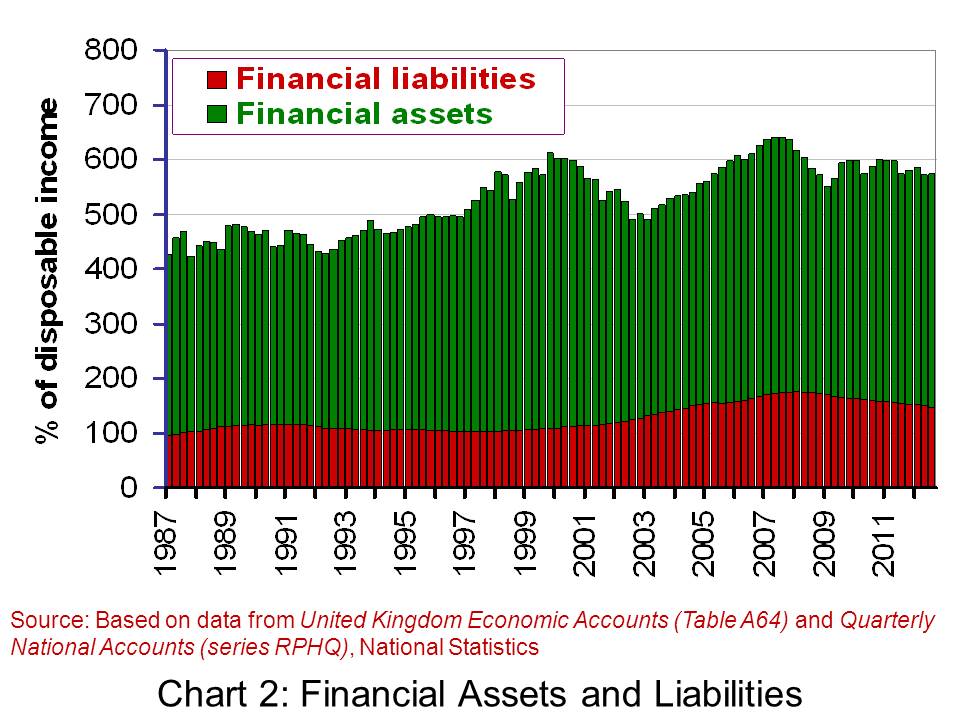 The spectre of debt has awoken many of us in the night. Indebtedness is a key economic issue in the 2010s. Economists are devoting ever increasing amounts of research time trying to understand its impact on economic behaviour. This will not surprise you when you learn that the debt owed by the UK non-bank private sector to banks stood at £2.17 trillion at the end of September. This is the equivalent to 150% of annual GDP.
The spectre of debt has awoken many of us in the night. Indebtedness is a key economic issue in the 2010s. Economists are devoting ever increasing amounts of research time trying to understand its impact on economic behaviour. This will not surprise you when you learn that the debt owed by the UK non-bank private sector to banks stood at £2.17 trillion at the end of September. This is the equivalent to 150% of annual GDP.
 Chart 1 shows the stock of outstanding lending by Monetary Financial Institutions (banks and building societies) to the non-bank private sector bank since 1979. Back then the non-bank private sector had bank debt to the tune of around £70 billion or 10 per cent of GDP. Today’s figure is nearly 3000 per cent higher! Of this debt, around about 55 per cent is currently held by the household sector, 27 per cent by Other Financial Corporations (such as insurance companies and pension funds) and 18 per cent by private non-financial corporations. (Click here for a PowerPoint of the chart.)
Chart 1 shows the stock of outstanding lending by Monetary Financial Institutions (banks and building societies) to the non-bank private sector bank since 1979. Back then the non-bank private sector had bank debt to the tune of around £70 billion or 10 per cent of GDP. Today’s figure is nearly 3000 per cent higher! Of this debt, around about 55 per cent is currently held by the household sector, 27 per cent by Other Financial Corporations (such as insurance companies and pension funds) and 18 per cent by private non-financial corporations. (Click here for a PowerPoint of the chart.)
 Chart 2 shows the stocks of debt as percentages of annual GDP. We can infer from it that there are waves of growth in bank debt. Two notable periods are during the 1980s and again from the late 1990s up to the financial crisis of the late 2000s. During the early and mid 1990s the relative size of debt stocks tended to stabilise while in the early 2010s the actual stocks of debt, as well as relative to GDP, declined. A credit binge seems to be followed by a period of consolidation. (Click here for a PowerPoint of the chart.)
Chart 2 shows the stocks of debt as percentages of annual GDP. We can infer from it that there are waves of growth in bank debt. Two notable periods are during the 1980s and again from the late 1990s up to the financial crisis of the late 2000s. During the early and mid 1990s the relative size of debt stocks tended to stabilise while in the early 2010s the actual stocks of debt, as well as relative to GDP, declined. A credit binge seems to be followed by a period of consolidation. (Click here for a PowerPoint of the chart.)
It is important that we understand the drivers of the growth of debt. The impact of debt on the balance sheets of the non-bank private sector and on banks themselves has implications for economic behaviour. In the early 2010s this has been to markedly slow the pace of growth through its impact on aggregate demand. Economic agents have, in general, looked to consolidate. There is no doubt that this partly reflects a precautionary motive. An important means by which debt and the balance sheets on which it is recorded affect behaviour is through a precautionary mechanism. This is difficult to accurately quantify because it represents a psychological influence on spending. Furthermore, it is affected by the prevailing circumstances of the time.
In looking to understand the factors that affect the growth of debt we may, as a result, learn more about the framework within which we may want banks and their customers to operate. Consequently, we may be in a better position to ensure sustainable longer-term growth and development. If there are cycles in credit it is important that we understand why they arise and whether, as some have suggested, they are an inherent part of the financialised economy in which we live. If they are, can we mitigate their potentially destabilising effects?
Articles
Retail shares facing nightmare before Christmas The Telegraph, John Ficenec (9/11/14)
Growing wealth inequality in the UK is a ticking timebomb The Guardian, Danny Dorling (15/10/14)
Richest 10% of Britons now control more than half the country’s wealth: Nation is only member of G7 where inequality between rich and poor has increased this century Mail Online, Mark Duell and Corey Charlton, (15/11/14)
Household debt is growing as families struggle Yorkshire Evening Post (31/10/14)
Consumer spending forecast to be the highest for four years The Telegraph, Ashley Armstrong (10/11/14)
Data
Statistical Interactive Database Bank of England
Quarterly National Accounts, Q2 2014 Dataset Office for National Statistics
Questions
- What is the non-bank private sector?
- What factors might affect the rate at which non-bank private sector debt stocks grow?
- How might we go about assessing whether the aggregate level of lending by financial institutions to the non-bank private sector is sustainable?
- How might we go about assessing whether the level of lending by individual financial institutions to the non-bank private sector is sustainable?
- What information is conveyed in the balance sheets of economic agents, such as households and private non-financial corporations
- What is meant by precautionary saving?
- Can precautionary saving occur when the economy is growing strongly?
- What are the mechanisms by which non-bank private sector debt could impact on economic behaviour?


